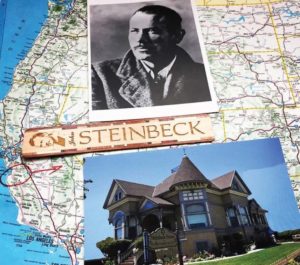
John Steinbeck wrote about the Great Depression and of those moving to the South Valley during difficult times. However, he grew up on the Coast, which he also wrote about, and a trip to the National Steinbeck Center is well worth a stop or even an intended trip to Salinas.
Located on One Main Street in Salinas, the Center is a monument to the late Nobel Prize winning author.
According to the Center’s website,
“Rooted in the earth and the people of the Salinas Valley, Steinbeck achieved worldwide recognition for his keen observations and powerful descriptions of the human condition. He championed the forgotten and disenfranchised, while affirming the strength of the human spirit. His life was as rich and provocative as the Salinas Valley he immortalized in his writing. Steinbeck drew his inspiration from this land and became known throughout the world, receiving the Nobel Prize for Literature in 1962.”
Founded in 1983, the Center opened to the public in 1998. It contains the largest compilation of Steinbeck’s works and has a wing devoted to California agriculture and agricultural workers, which the author was passionate about.
The building itself was sold to California State University, Monterey Bay, with a long-term lease back to the Center, according to Eric Mora, marketing and membership coordinator for the Center.
The Center strives to share Steinbeck’s values with its visitors through interactive and multimedia exhibits. On exhibit are rare artifacts such as the Steinbeck’s camper which he took on his road trip around the country resulting in the book, Travels with Charley, and themed theaters showcasing films on the author’s works including Cannery Row, Grapes of Wrath and Of Mice and Men.
Upcoming events at the National Steinbeck Center include Steve Webster, “”What would Steinbeck and Ricketts Say about Climate Change?” on Sunday, June 5 from 3-4:30pm at the Center. Dr. Steve Webster, co-founder of the Monterey Bay Aquarium, will give a talk on climate change which will explore what John Steinbeck and Ed Ricketts would likely be saying about climate change, were they here today.
Steinbeck, in his own words, was “a student of the mutual relationship between organism and environment.” This worldview developed throughout his years of friendship and collaboration with Ricketts and is, perhaps, best expressed in Sea of Cortez.
Two blocks from the Center, within walking distance, is the family home of John Steinbeck, which has been transformed into a luncheon restaurant. Owned by the Valley Guild, a non-profit, volunteer organization, whose primary purpose is to maintain the Steinbeck House, docent-led talks are offered to diners by reservation.
Starting in June the Steinbeck House will be open for dinner the first Friday of each month. And during the summer, tours will be offered on the first Sunday of the month.
John Steinbeck was an author well-known by the Baby Boom generation for writing about American during the Great Depression.
Born in 1902, he was a voracious reader, even at a young age when he also began writing.
Although famed mostly as a novel author for the era, he also served as a war correspondent for the New York Herald Tribune during World War II and his writings were published in book form in the late ‘50s as Once There was a War.
He had been denied a commission in the military, as his writings were thought to be of communist leadings and he was investigated by the FBI for the Grapes of Wrath.
One of his last books was Travels with Charley.
According to the Center’s website –
“That year [1962] also saw publication of one of his most endearing books, Travels with Charley (1962). ‘I’m going to learn about my own country,’ Steinbeck wrote to a friend, before he began his trip around America. He felt that he had lost touch with his own country:
I, an American writer, writing about America, was working from memory, and the memory at best is a faulty, warpy reservoir. I had not heard the speech of America, smelled the grass and trees and sewage, seen its hills and water, its color and quality of light. I knew the changes only from books and newspapers. But more than this, I had not felt the country for twenty-five years.
Through the National Steinbeck Center and the Steinbeck House, his legacy lives on.
For more information on the Steinbeck House, visit steinbeckhouse.com.
For more information on the National Steinbeck Center and upcoming events, visit www.steinbeck.org.
